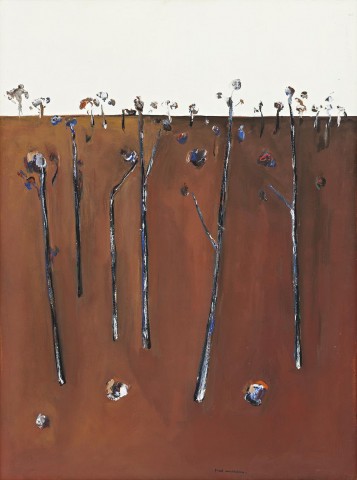UNTITLED LANDSCAPE II, c.1966
FRED WILLIAMS
gouache on paper
75.5 x 57.5 cm
signed lower right: Fred Williams
Rudy Komon Gallery, Sydney (label attached verso)
Mr James Cromie, Sydney
Thence by descent
Private collection, Melbourne
Art Equity, Sydney (label attached verso)
Private collection, Malaysia
Accompanied by a certificate of authenticity, Rex Irwin Art Dealer, Sydney, signed and dated 29 July 2010.
Untitled Landscape II, c.1966, is a dramatic and bold picture, with subtle highlights of white, royal blue and orange suspended over a velvety burnt sienna ground. Six tall saplings dominate the foreground of this gouache, some stretching almost the full length of the picture towards the horizon line, echoing the claustrophobia of Fred Williams’ earlier Forest series. These monumental forms dominating the composition are strongly counterbalanced by the overall sparseness of the landscape and Williams’ delicate gesture. Its dark colours, whilst warm in tone, produce an arid and melancholy vision of the Australian outback. Tenebrous and brooding, this gouache, and many others of this time were painted at the end of the day, the artist approaching his familiar landscape from an alternative tonal perspective. The strong contrast between the blackened trunks and white highlights suggest a recent bushfire, foreshadowing the inspiration this apocalyptic theme would provide to the artist later in life. Here, Williams nourishes the myth of the unknown Australian landscape, ashen and austere but also universal and unifying in its elemental power and archetypal forms.
Williams devoted his life to the creation of a contemporary approach to the romantic tradition of landscape painting, creating instead a distinctive gestural visual language that presented only the most essential elements of the subject, displaying the strangeness of the Australian environment with sincerity and respect for its history. Irregular and asymmetric, Williams’ compositions show the ancient and untameable landscape of the Antipodes, almost always devoid of human presence and constructions. Williams had a sophisticated understanding of colour, using it sparingly to evoke form and space in this period of his career – in contrast to the riotous colours of the later Weipa and Pilbara series.
Painted in the bushy hinterland of Melbourne, this gouache, like its yellow companion piece bears the same strong and high horizon line bisecting earth and sky characteristic of his paintings of the late 1960s. In these Upwey landscapes, the daubs and dashes of Williams’ brush are suspended above a flat and uniform ground. Here, it is the sparseness and scale of the landscape that provide the focus for Williams’ image; the silhouetted tree canopies stretching beyond the horizon, swampy ponds at their roots only just discernible amongst Williams’ idiomatic brushstrokes.
LUCIE REEVES-SMITH
